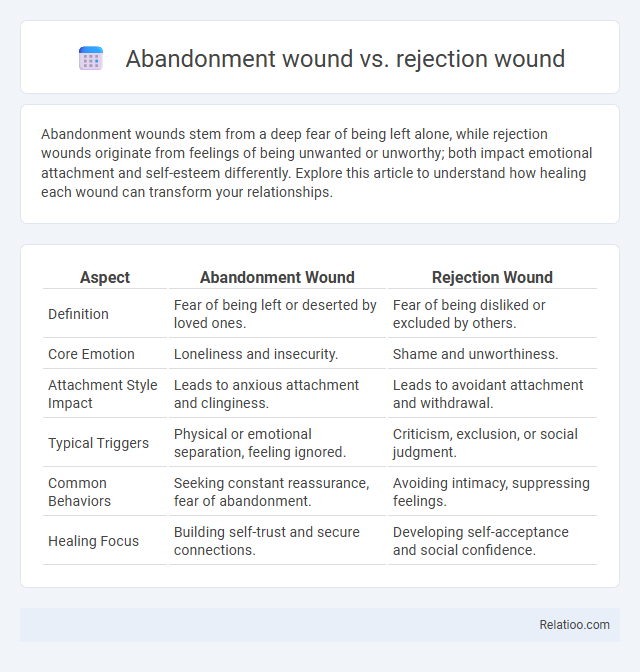Abandonment wounds stem from a deep fear of being left alone, while rejection wounds originate from feelings of being unwanted or unworthy; both impact emotional attachment and self-esteem differently. Explore this article to understand how healing each wound can transform your relationships.
Table of Comparison
| Aspect | Abandonment Wound | Rejection Wound |
|---|---|---|
| Definition | Fear of being left or deserted by loved ones. | Fear of being disliked or excluded by others. |
| Core Emotion | Loneliness and insecurity. | Shame and unworthiness. |
| Attachment Style Impact | Leads to anxious attachment and clinginess. | Leads to avoidant attachment and withdrawal. |
| Typical Triggers | Physical or emotional separation, feeling ignored. | Criticism, exclusion, or social judgment. |
| Common Behaviors | Seeking constant reassurance, fear of abandonment. | Avoiding intimacy, suppressing feelings. |
| Healing Focus | Building self-trust and secure connections. | Developing self-acceptance and social confidence. |
Understanding Abandonment Wounds
Abandonment wounds stem from the deep fear of being left alone or deserted, impacting Your emotional security and trust in relationships. Unlike rejection wounds, which arise from feelings of being unwanted or dismissed, abandonment wounds specifically relate to experiences of physical or emotional withdrawal by significant caregivers during formative years. Recognizing the unique triggers and emotional responses tied to abandonment wounds is crucial for healing and fostering healthier connections.
Defining Rejection Wounds
Rejection wounds occur when an individual feels profoundly unwanted or dismissed by others, often leading to deep emotional pain and a sense of unworthiness. Unlike abandonment wounds, which stem from physical or emotional neglect due to being left alone or ignored, rejection wounds are tied specifically to feelings of being refused or excluded. Understanding how rejection wounds impact your self-esteem and relationships is crucial for healing and fostering healthy connections.
Core Differences: Abandonment vs Rejection
Abandonment wounds stem from the fear of being left alone or neglected by significant others, causing deep-seated insecurity and difficulty trusting others. Rejection wounds arise from experiences of being dismissed, excluded, or deemed unworthy, leading to feelings of unlovability and social anxiety. Understanding these core differences helps you identify your emotional triggers and develop healthier relational patterns.
Signs of an Abandonment Wound
Signs of an abandonment wound often include feelings of deep insecurity, chronic fear of being left alone, and difficulty trusting others. You may experience intense emotional pain, clinginess in relationships, or avoidance of intimacy to protect yourself from perceived rejection. These symptoms distinguish abandonment wounds from rejection wounds, which typically center more on feeling unwanted or unworthy rather than specifically fearing physical or emotional desertion.
Common Symptoms of Rejection Wounds
Common symptoms of rejection wounds include intense feelings of unworthiness, emotional pain, and fear of being unloved or excluded. These wounds often trigger anxiety, low self-esteem, and difficulty trusting others, which can lead to social withdrawal and heightened sensitivity to criticism. Unlike abandonment wounds that primarily stem from physical or emotional neglect, rejection wounds specifically arise from experiences of being denied acceptance or approval.
Psychological Origins and Root Causes
Abandonment wounds originate from early experiences of neglect or inconsistent caregiving, leading to deep fears of being left alone or unsupported. Rejection wounds stem from feeling unwanted or excluded, often triggered by critical relationships or social environments that convey unworthiness. While abandonment wounds focus on the absence of care and security, rejection wounds center on perceived denials of acceptance and belonging, both rooted in significant relational traumas during childhood.
Long-Term Effects on Relationships
Abandonment wounds often lead to fear of being left alone, causing clinginess or avoidance in relationships, while rejection wounds can result in deep insecurity and difficulty trusting others. Your capacity to form healthy attachments may be compromised as both wounds trigger emotional defenses that hinder intimacy and communication. Understanding these long-term effects helps address patterns of mistrust and emotional withdrawal, promoting healing and stronger relational bonds.
Healing Abandonment and Rejection Wounds
Healing abandonment and rejection wounds requires understanding their distinct emotional impacts: abandonment wounds stem from feelings of being left alone or neglected, while rejection wounds arise from perceived disapproval or exclusion. You can foster recovery by cultivating self-compassion, setting healthy boundaries, and seeking supportive relationships that validate your worth. Therapeutic approaches such as cognitive-behavioral therapy and trauma-informed counseling provide effective tools to reframe negative beliefs and promote emotional resilience.
Coping Strategies and Therapeutic Approaches
Coping strategies for abandonment wounds emphasize building self-worth and establishing secure attachments through mindfulness and self-compassion exercises, while therapeutic approaches often utilize cognitive-behavioral therapy (CBT) and emotionally focused therapy (EFT) to address relational patterns. Rejection wounds require strategies that focus on resilience and reframing negative self-beliefs, with therapies such as acceptance and commitment therapy (ACT) and dialectical behavior therapy (DBT) proving effective in managing emotional dysregulation. Differentiating between abandonment and rejection wounds aids clinicians in tailoring interventions, including trauma-informed care and attachment-based therapy, to promote healing and relational stability.
Moving Forward: Building Emotional Resilience
Abandonment wounds, rejection wounds, and betrayal wounds each result from distinct emotional traumas that affect trust and self-worth, requiring tailored approaches to healing. Moving forward involves cultivating emotional resilience by developing self-compassion, setting healthy boundaries, and practicing mindfulness to process and regulate difficult emotions effectively. Integrating therapeutic techniques such as cognitive-behavioral therapy (CBT) and somatic experiencing can reinforce recovery and promote long-term psychological well-being.

Infographic: Abandonment wound vs Rejection wound
 relatioo.com
relatioo.com